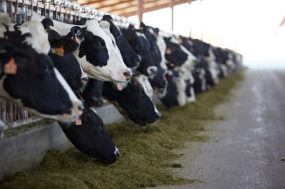This article helps answer a question we often get when talking to dairy farmers: Is it better to have two dry cow diets – far-off and close-up, or is one dry cow diet throughout the dry period enough? The authors designed three diets: a low-energy (LO), high-fibre diet fed throughout the dry period; a high-energy (HI) diet fed throughout the dry period; and a combination of these (LO+HI), namely a low-energy diet fed during the far-off period and a high-energy diet fed during the close-up period.
The objective was to determine if the low-energy diet fed throughout the dry period improved metabolic status and production of dairy cows compared with the other two. Three groups of 25 Holstein cows (with 10 primiparous cows in each group) were assigned to each of three diets at 60 days before expected calving.
The authors indicate that controlled feeding of cows during the dry period affects peri-parturient health, post-calving dry matter intake (DMI) and lactation performance. Some studies found that nutrition during the far-off dry period was more important than nutrition during the close-up dry period for transition success. They also refer that restricting the amount of feed offered to cows is difficult in freestall group housing systems. Aggressive cows will have ad libitum intake, whereas more timid cows may have severely restricted intake. This led to the idea of including straw or other bulky forage in a TMR to provide a way for feeding for ad libitum DMI while still controlling energy intake.
The authors say that many farmers continue to use a “steam-up” or close-up diet of greater nutrient density before calving based on recommendations from nutritionists but that, surprisingly, little research evidence exists to support this practice. On the other hand, single-diet, single-group dry cow programs have merit for small- to medium-size farms that have difficulties creating multiple pens and multiple TMRs for cows. Moreover, many farms commingle first-calving heifers with older cows in such management schemes, but little research is available to assess the nutritional outcomes of this practice.
The results of the study confirm the generally favourable metabolic responses in cows fed LO throughout the dry period, compared with HI or LO+HI. They also indicate an increase in lipid accumulation in the liver and greater ketogenesis due to body reserve mobilization in HI cows, increasing the likelihood of fatty liver and subsequent disorders and diseases. Controlling the energy intake of cows during the dry period minimizes lipid accumulation and ketogenesis in the liver postpartum.
Compared with LO, the LO+HI treatment in this study did not appreciably benefit cows in any way except for small increases in milkfat. Thus, the additional feed and inconvenience of formulating a separate diet for a separate group would not be justified by significant economic benefit. Indeed, the increased liver fat accumulation and prolonged elevation of BHB postpartum suggests this approach might actually increase metabolic risk to cows postpartum. During the study, primiparous cows generally responded to diets the same as multiparous cows. The LO+HI feeding strategy provided no benefit over the LO diet.
“Hot topic: Detecting digital dermatitis with computer vision” Journal of Dairy Science Vol. 103 No. 10, 2020
This study, from researchers at the University of Wisconsin, aimed to develop and implement a novel computer vision (COMV) tool to identify digital dermatitis (DD) (also called strawberry) lesions on a commercial dairy farm. For this, they used a database of 3,500 DD lesion images and trained a model to detect the M-stages of DD.
DD is painful. It is linked to decreased milk production, severe lameness and infertility, and is considered a major animal welfare and production problem in dairy cattle. The authors say prompt identification and treatment of lesions reduces prevalence within a herd but requires extensive employee training in an industry with a high employee turnover rate. Consequently, DD detection is often suboptimal on commercial dairy farms.
This is where COMV comes into play. The authors mentioned that COMV methods for disease detection, such as those used for facial and fingerprint recognition on hand-held devices, are becoming more common in veterinary medicine and provide a unique opportunity for DD detection. Even though early detection of DD is difficult, computer vision could be used to improve early DD detection on commercial dairy farms.
All images in the study database were scored for M-stages of DD by a trained investigator using the M-stage DD classification system described by Dopfer et al. (1997) and Berry et al. (2012). Based on this classification system, cattle images in which normal skin was observed on the foot were classified as M0 (healthy claws). Images that showed acute, active ulcerative DD lesions greater than or equal to 20 millimetres in diameter were classified as M2, and images that showed chronic lesions characterized by a thickened epithelium (hyperkeratosis) were classified as M4H (chronically affected claws).
The authors tested the system in a commercial farm in real time, placing a camera in a rotary parlor at the hoof level so the camera got images of the cows’ hooves as they passed in front of it. Simultaneously, a trained investigator also classified the same cows. The study concluded that the model detected DD with an accuracy of 88%.
Looking ahead, the authors say an ideal COMV model for DD detection would have two additional components: expansion of the training database to include more images and increase the number of farms for greater on-farm implementation. In addition, an application for handheld devices would allow commercial producers, veterinarians, hoof trimmers and other cow professionals to take pictures of DD lesions and obtain scores of M-stages automatically in real time. Implementation of COMV tools for DD detection provides an opportunity to identify cows for DD treatment, which has the potential to lower DD prevalence and improve animal welfare on commercial dairy farms.
This column brings you information regarding some of the research being done around the world and published in the Journal of Dairy Science. The objective is to bring to light areas of research that may have an immediate practical application on a dairy farm, as well as research that, even though may not have a practical impact now, could be interesting for its future potential application. The idea is to give a brief overview of select research studies, but not go into detail on each topic. Those interested in further in-depth reading can find each study online.










